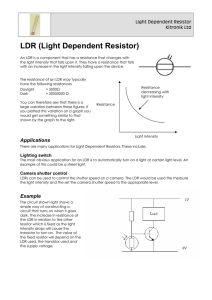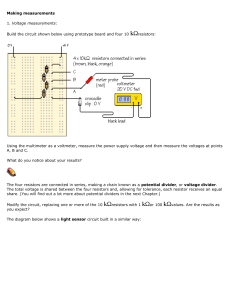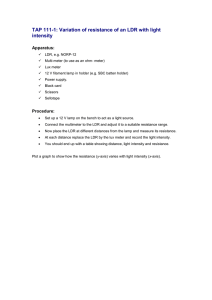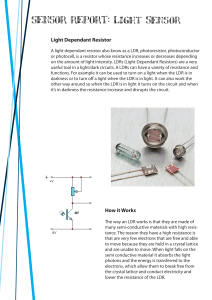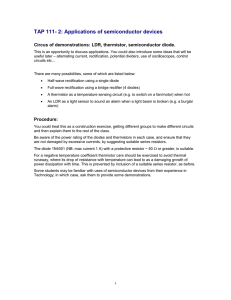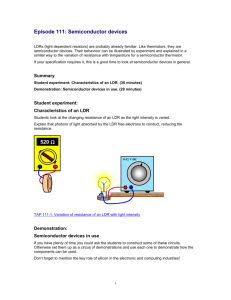A Light Dependent Resistor (aka LDR, photoconductor, photocell, or
advertisement
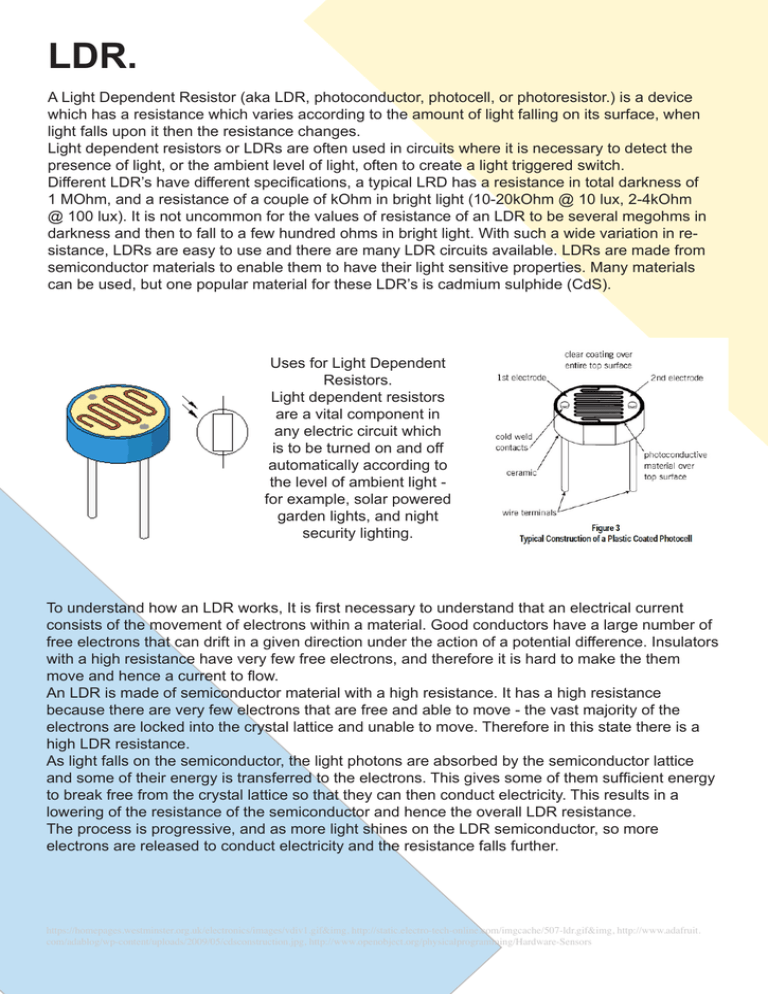
LDR. A Light Dependent Resistor (aka LDR, photoconductor, photocell, or photoresistor.) is a device which has a resistance which varies according to the amount of light falling on its surface, when light falls upon it then the resistance changes. Light dependent resistors or LDRs are often used in circuits where it is necessary to detect the presence of light, or the ambient level of light, often to create a light triggered switch. Different LDR’s have different specifications, a typical LRD has a resistance in total darkness of 1 MOhm, and a resistance of a couple of kOhm in bright light (10-20kOhm @ 10 lux, 2-4kOhm @ 100 lux). It is not uncommon for the values of resistance of an LDR to be several megohms in darkness and then to fall to a few hundred ohms in bright light. With such a wide variation in resistance, LDRs are easy to use and there are many LDR circuits available. LDRs are made from semiconductor materials to enable them to have their light sensitive properties. Many materials can be used, but one popular material for these LDR’s is cadmium sulphide (CdS). Uses for Light Dependent Resistors. Light dependent resistors are a vital component in any electric circuit which is to be turned on and off automatically according to the level of ambient light for example, solar powered garden lights, and night security lighting. To understand how an LDR works, It is first necessary to understand that an electrical current consists of the movement of electrons within a material. Good conductors have a large number of free electrons that can drift in a given direction under the action of a potential difference. Insulators with a high resistance have very few free electrons, and therefore it is hard to make the them move and hence a current to flow. An LDR is made of semiconductor material with a high resistance. It has a high resistance because there are very few electrons that are free and able to move - the vast majority of the electrons are locked into the crystal lattice and unable to move. Therefore in this state there is a high LDR resistance. As light falls on the semiconductor, the light photons are absorbed by the semiconductor lattice and some of their energy is transferred to the electrons. This gives some of them sufficient energy to break free from the crystal lattice so that they can then conduct electricity. This results in a lowering of the resistance of the semiconductor and hence the overall LDR resistance. The process is progressive, and as more light shines on the LDR semiconductor, so more electrons are released to conduct electricity and the resistance falls further. https://homepages.westminster.org.uk/electronics/images/vdiv1.gif&img, http://static.electro-tech-online.com/imgcache/507-ldr.gif&img, http://www.adafruit. com/adablog/wp-content/uploads/2009/05/cdsconstruction.jpg, http://www.openobject.org/physicalprogramming/Hardware-Sensors Light Dependent Resistor Circuits. There are two basic circuits using light dependent resistors - the first is activated by darkness, the second is activated by light. The two circuits are very similar and just require an LDR, some standard resistors, a variable resistor (aka potentiometer), and any small signal transistor. (LED) LDR darkness activated circuit. In the left circuit diagram above, the LED lights up whenever the LDR is in darkness. The 10K variable resistor is used to fine-tune the level of darkness required before the LED lights up. The 10K standard resistor can be changed as required to achieve the desired effect, although any replacement must be at least 1K to protect the transistor from being damaged by excessive current. By swapping the LDR over with the 10K and 10K variable resistors, the circuit will be activated instead by light. Whenever sufficient light falls on the LDR (manually fine-tuned using the 10K variable resistor), the LED will light up. Because photocells are basically resistors, they are non-polarized. That means you can connect them up ‘either way’ and they’ll work just fine. Basic Light Dependent Resistors (LDRs), as shown above, are available from Jaycar and SparkFun for as little as $2.00. More advanced light sensors, like the one above from Modern Devices for US$5.00 and this one from SparkFun for US$6.00 are also available. Michelle McDonell s3016468

